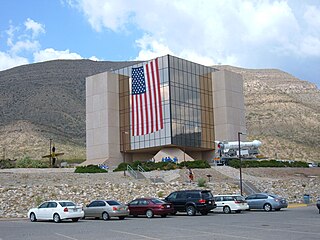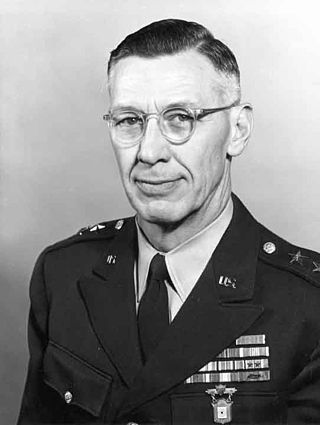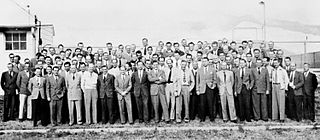
Wernher Magnus Maximilian Freiherr von Braun was a German-American aerospace engineer and space architect. He was a member of the Nazi Party and Allgemeine SS, the leading figure in the development of rocket technology in Nazi Germany, and later a pioneer of rocket and space technology in the United States.

Huntsville is the most populous city in the U.S. state of Alabama. It is the county seat of Madison County with portions extending into Limestone County and Morgan County. It is located in the Appalachian region of northern Alabama south of the state of Tennessee.

The PGM-11 Redstone was the first large American ballistic missile. A short-range ballistic missile (SRBM), it was in active service with the United States Army in West Germany from June 1958 to June 1964 as part of NATO's Cold War defense of Western Europe. It was the first US missile to carry a live nuclear warhead, in the 1958 Pacific Ocean weapons test Hardtack Teak.

Operation Paperclip was a secret United States intelligence program in which more than 1,600 German scientists, engineers, and technicians were taken from former Nazi Germany to the U.S. for government employment after the end of World War II in Europe, between 1945 and 1959. Most were former members and leaders of the Nazi Party.

The New Mexico Museum of Space History is a museum and planetarium complex in Alamogordo, New Mexico, United States, dedicated to artifacts and displays related to space flight and the Space Age. It includes the International Space Hall of Fame. The Museum of Space History highlights the role that New Mexico has had in the U. S. space program, and is one of eight museums administered by the New Mexico Department of Cultural Affairs. The museum has been accredited by American Alliance of Museums since 1993. The museum is also a Smithsonian Affiliate.

Nancy Jan Davis is a former American astronaut. A veteran of three space flights, Davis logged over 673 hours in space. She is now retired from NASA.

The University of Alabama in Huntsville (UAH) is a public research university in Huntsville, Alabama. The university is accredited by the Southern Association of Colleges and Schools and comprises eight colleges: arts, humanities & social sciences; business; education; engineering; honors; nursing; science; and graduate. The university's enrollment is approximately 10,000. It is part of the University of Alabama System and is classified among "R1: Doctoral Universities: Very High Research Activity".

The U.S. Space & Rocket Center in Huntsville, Alabama is a museum operated by the government of Alabama, showcasing rockets, achievements, and artifacts of the U.S. space program. Sometimes billed as "Earth's largest space museum", astronaut Owen Garriott described the place as, "a great way to learn about space in a town that has embraced the space program from the very beginning."
The International Space Development Conference (ISDC) is the annual conference of the National Space Society (NSS). Now in its 41st year, these conferences connect the general public and the NSS membership with leaders of contemporary space efforts. The ISDC provides a nexus for industry, government, scientists, advocates, and the public to meet and discuss the latest issues in space technology, science, policy, commerce, medicine, exploration, settlement and much more. Winners of the annual NASA space settlement Contest annually attend the conference, with several interesting activities and programs. With National Space Society's major goal being to accelerate the process of space exploration and development they also foster astronautics for students by encouraging them and getting them involved.

The Kennedy Space Center Visitor Complex is the visitor center at NASA's Kennedy Space Center on Merritt Island, Florida. It features exhibits and displays, historic spacecraft and memorabilia, shows, two IMAX theaters, and a range of bus tours of the spaceport. The "Space Shuttle Atlantis" exhibit contains the Atlantis orbiter and the Shuttle Launch Experience, a simulated ride into space. The center also provides astronaut training experiences, including a multi-axial chair and Mars Base simulator. The visitor complex also has daily presentations from a veteran NASA astronaut. A bus tour, included with admission, encompasses the separate Apollo/Saturn V Center. There were 1.7 million visitors to the visitor complex in 2016.

The United States Astronaut Hall of Fame, located inside the Kennedy Space Center Visitor Complex Heroes & Legends building on Merritt Island, Florida, honors American astronauts and features the world's largest collection of their personal memorabilia, focusing on those astronauts who have been inducted into the Hall. Exhibits include Wally Schirra's Sigma 7 space capsule from the fifth crewed Mercury mission and the Gemini IX spacecraft flown by Gene Cernan and Thomas P. Stafford in 1966.

Konrad Dannenberg was a German-American rocket pioneer and member of the German rocket team brought to the United States after World War II.

The McAuliffe-Shepard Discovery Center is a science museum located in Concord, New Hampshire, United States, next door to the NHTI campus. The museum is dedicated to Christa McAuliffe, the Concord High School social studies teacher selected by NASA out of over 11,000 applicants to be the first teacher in space, and Alan Shepard, the Derry, New Hampshire, native and Navy test pilot who became the first American in space and one of only twelve human beings to walk on the Moon. The Discovery Center's stated mission is to inspire new generations to explore space, through engaging, artful, and entertaining activities focused on astronomy, aviation, Earth and space science.

The Cox Science Center and Aquarium, formerly the South Florida Science Center and Aquarium, is a science museum located in West Palm Beach, Florida. Founded in 1959, the goal of the organization is to open every mind to science through the strategic programming of interactive exhibits and engaging community-based camps and events. The Cox Center has expanded since its creation and now houses over 50 hands-on exhibits, a planetarium, a 3000 square foot aquarium, a miniature golf course, and a large exhibit space that displays a temporary travelling exhibit. The Cox Center is a member of the Association of Science-Technology Centers program, which offers a membership that is redeemable at other ASTC science and technology centers around the world. The Cox Center occupies Dreher Park alongside the Palm Beach Zoo and offers deals for entrance into both facilities.

Major General Holger Nelson Toftoy was a United States Army career officer instrumental to the development of the United States' early rocketry after World War II, such as the Redstone missile. He persuaded senior officers to bring German scientists to the US after the war, to make use of their expertise, and supervised the relocation of more than 119 scientists.

The Astronaut Memorial Planetarium and Observatory, or AMPO, also known as the Eastern Florida State College Planetarium and Observatory, was an astronomical observatory and planetarium at Eastern Florida State College in Cocoa, Florida. The facility consisted of a planetarium, public observatory, large-screen movie theater, exhibit halls, multi-media classroom and an art gallery.

Georg Heinrich Patrick Baron von Tiesenhausen was a Baltic-German-born American rocket scientist.

JoAnn Hardin Morgan is an American aerospace engineer who was the first female engineer at the National Aeronautics and Space Administration (NASA) John F. Kennedy Space Center and the first woman to serve as a senior executive at Kennedy Space Center. For her work at NASA, Morgan was honored by U.S. President Bill Clinton as a Meritorious Executive in 1995 and 1998. Prior to her retirement in 2003, she held various leadership positions over 40 years in the human space flight programs at NASA. Morgan served as the director of the External Relations and Business Development during her final years at the space center.

Alabama's first aeronautical event was on 10 March 1910 with the flight of a Wright biplane flown by Orville Wright in Montgomery, Alabama.

Oscar Carl Holderer was an engineer who worked for Nazi Germany during World War II before coming to the United States and working in the Apollo space program.























